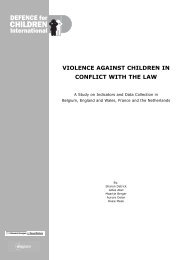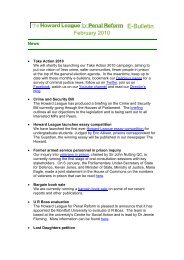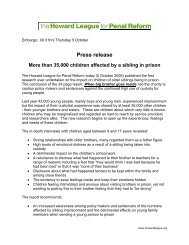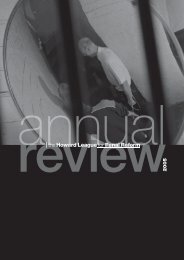Young, neglected and back: young men in prison - The Howard ...
Young, neglected and back: young men in prison - The Howard ...
Young, neglected and back: young men in prison - The Howard ...
- No tags were found...
Create successful ePaper yourself
Turn your PDF publications into a flip-book with our unique Google optimized e-Paper software.
<strong>Young</strong>, <strong>neglected</strong> <strong>and</strong> <strong>back</strong>: <strong>Young</strong> <strong>men</strong> <strong>in</strong> <strong>prison</strong><br />
<strong>The</strong> policy <strong>back</strong>ground<br />
<strong>Young</strong> adult <strong>prison</strong>ers are the forgotten <strong>and</strong> <strong>neglected</strong> section of the<br />
<strong>prison</strong> population (<strong>Howard</strong> League for Penal Reform, 2003). <strong>The</strong><br />
Crim<strong>in</strong>al Justice <strong>and</strong> Court Services Act 2000 abolished the sentence<br />
of Detention <strong>in</strong> a <strong>Young</strong> Offender Institution. A commit<strong>men</strong>t<br />
was made by the Govern<strong>men</strong>t not to imple<strong>men</strong>t the abolition until<br />
a Prison Service Order (PSO) had been issued. (Prison Service<br />
Orders provide detailed guidance to <strong>prison</strong> staff on how to imple<strong>men</strong>t<br />
policy). <strong>The</strong>re is some concern that, without any clear direction,<br />
<strong>and</strong> <strong>in</strong> order to cut costs, the implicit recognition of the needs of this<br />
age group will be lost. In 2000, the Govern<strong>men</strong>t said that prepar<strong>in</strong>g<br />
any such PSO would <strong>in</strong>volve ‘consultation with <strong>in</strong>terested bodies’.<br />
<strong>The</strong>refore, any adm<strong>in</strong>istrative changes that affect <strong>young</strong> adults<br />
should only be made follow<strong>in</strong>g extensive consultation.<br />
In 2001 the Govern<strong>men</strong>t’s manifesto stated that:<br />
“We will build on our youth justice reforms to improve the<br />
st<strong>and</strong>ard of custodial accommodation <strong>and</strong> offend<strong>in</strong>g behaviour<br />
programmes for 18–20 year old offenders.”<br />
(Labour Party Manifesto, 2001)<br />
However, the Labour Party Manifesto 2005 conta<strong>in</strong>ed no specific<br />
reference to the needs of this age group despite grow<strong>in</strong>g evidence<br />
that <strong>young</strong> adult <strong>prison</strong>ers have a raft of specific needs that are not<br />
be<strong>in</strong>g met. Follow<strong>in</strong>g years of neglect <strong>and</strong> with no strategic focus<br />
on <strong>young</strong> adults, simply transferr<strong>in</strong>g these <strong>young</strong> people <strong>in</strong>to an illprepared,<br />
<strong>and</strong> already overstretched adult <strong>prison</strong> estate is unlikely<br />
to meet their needs.<br />
<strong>The</strong> most recent annual report from the Chief Inspector of Prisons<br />
(2005) yet aga<strong>in</strong> raised concerns about the needs of <strong>young</strong> adults.<br />
<strong>The</strong>se <strong>in</strong>cluded:<br />
Reports that 32% of <strong>young</strong> adults had at some time felt unsafe<br />
whilst they were <strong>in</strong> <strong>prison</strong>.<br />
<strong>Young</strong> adults were mix<strong>in</strong>g with older <strong>prison</strong>ers.<br />
A lack of appropriate places for <strong>young</strong> adults, with many held <strong>in</strong><br />
<strong>prison</strong>s with multiple populations.<br />
<strong>Young</strong> adults were often held at a great distance from home; <strong>and</strong><br />
were liable to be moved between sites, at short notice <strong>and</strong> for short<br />
periods of time.<br />
Between 1994 <strong>and</strong> 2004 the number of <strong>young</strong> adult <strong>men</strong> <strong>in</strong> <strong>prison</strong><br />
rose by over 20% (Hansard, House of Lords written answer 7 April<br />
2005). Furthermore, over 20% of <strong>prison</strong>s hold just one <strong>young</strong> adult<br />
– a situation which is unlikely to make the <strong>young</strong> person feel safe,<br />
<strong>and</strong> where it is doubtful that adequate consideration of their age specific<br />
needs can be given (Hansard, House of Lords written answer<br />
7 April 2005).<br />
<strong>The</strong> Chief Inspector of Prisons concludes that <strong>young</strong> adults:<br />
“Still rema<strong>in</strong> some of the most overlooked <strong>and</strong> underresourced<br />
<strong>prison</strong>ers. Our reports record significant gaps<br />
between the provision for juveniles <strong>and</strong> <strong>young</strong> adults…<br />
Some establish<strong>men</strong>ts resembled transit camps, rather than<br />
effective <strong>young</strong> offender <strong>in</strong>stitutions…Bully<strong>in</strong>g is a particular<br />
concern for this age-group.”<br />
(HMCIP, 2005)<br />
<strong>The</strong> transition: childhood to adulthood<br />
<strong>Young</strong> people’s lives change rapidly <strong>and</strong> dramatically between the<br />
ages of 16 <strong>and</strong> 25 (Social Exclusion Unit, 2004). A move towards<br />
<strong>in</strong>dependence – the transition to adulthood – generally occurs at this<br />
time. Dur<strong>in</strong>g this transition, there is an <strong>in</strong>creas<strong>in</strong>g need to access<br />
services personally rather than through parents or carers. Moreover,<br />
dur<strong>in</strong>g this period of change there may be a greater need for<br />
services <strong>and</strong> other forms of <strong>in</strong>terventions to help support mak<strong>in</strong>g<br />
more <strong>in</strong>dependent decisions, many of which will affect the rest of a<br />
<strong>young</strong> person’s life.<br />
Seen as an important area of Govern<strong>men</strong>t policy, the Social Exclusion<br />
Unit (SEU) is currently undertak<strong>in</strong>g work on the transition from<br />
childhood to adulthood. Previous work by the SEU had shown that<br />
98% of <strong>young</strong> adults access<strong>in</strong>g services had more than one problem<br />
or need. <strong>Young</strong> adults who drop out of education, tra<strong>in</strong><strong>in</strong>g or<br />
work – or who drift <strong>in</strong>to crime – can face severe long-term personal,<br />
social <strong>and</strong> f<strong>in</strong>ancial consequences, as can their families (Social<br />
Exclusion Unit, 2005).<br />
<strong>Young</strong> people with severe or multiple needs – such as homelessness,<br />
substance misuse, offend<strong>in</strong>g or <strong>men</strong>tal health problems –<br />
need to access a range of services <strong>in</strong> order to address the various<br />
problems they have. But too often services approach someone’s<br />
problems as <strong>in</strong>dividual issues rather than look<strong>in</strong>g at them as <strong>in</strong>terrelated.<br />
As a result, <strong>in</strong>dividuals can f<strong>in</strong>d themselves on unpredictable<br />
<strong>and</strong> repetitive journeys around different agencies, or worse, on<br />
a downhill trajectory that further compounds their social exclusion<br />
(Social Exclusion Unit, 2005). <strong>The</strong> <strong>young</strong> <strong>men</strong> <strong>in</strong> this study had an<br />
array of needs that required some k<strong>in</strong>d of positive <strong>in</strong>tervention; all<br />
too often these needs were not met <strong>and</strong> resulted <strong>in</strong> a somewhat<br />
<strong>in</strong>evitable downward spiral <strong>in</strong>to offend<strong>in</strong>g <strong>and</strong> im<strong>prison</strong><strong>men</strong>t. One<br />
<strong>young</strong> man told us:<br />
“I was homeless… I got kicked out of home when I was 16<br />
<strong>and</strong> I was liv<strong>in</strong>g on my own from 16 until now, liv<strong>in</strong>g <strong>in</strong> all the<br />
different hostels <strong>and</strong> then I got a flat when I was 17 <strong>and</strong> all<br />
my mates would come round all the time <strong>and</strong> we turned it<br />
<strong>in</strong>to a party house <strong>and</strong> the police closed it down so I ended<br />
up be<strong>in</strong>g homeless aga<strong>in</strong>, lived with my gran for a week,<br />
<strong>and</strong> then I got sent <strong>in</strong> here.”<br />
(Jason, age 19)<br />
However, the SEU recognises that national policy makers have not<br />
placed sufficient weight on <strong>young</strong> people’s th<strong>in</strong>k<strong>in</strong>g <strong>and</strong> behaviour<br />
when they have designed policies aimed at them. <strong>The</strong>y conclude<br />
that ‘this oversight means that policy <strong>in</strong>terventions aimed at <strong>young</strong><br />
people risk fail<strong>in</strong>g’. It is essential that the views of <strong>young</strong> people are<br />
actively sought <strong>and</strong> used to <strong>in</strong>form policy decisions.<br />
From community to custody to community<br />
<strong>The</strong> unique aim of Out for Good is to provide the <strong>young</strong> <strong>men</strong> <strong>in</strong>terviewed<br />
the time <strong>and</strong> space to consider what they th<strong>in</strong>k would be<br />
funda<strong>men</strong>tal to their successful re<strong>in</strong>tegration <strong>in</strong>to society, provid<strong>in</strong>g<br />
them with the best opportunities to desist from crime. A variety<br />
of issues were <strong>men</strong>tioned rang<strong>in</strong>g from hav<strong>in</strong>g <strong>in</strong>dependent stable<br />
hous<strong>in</strong>g, to sett<strong>in</strong>g <strong>and</strong> achiev<strong>in</strong>g personal goals. <strong>The</strong> table below<br />
presents the resettle<strong>men</strong>t needs identified by the <strong>young</strong> <strong>men</strong> as<br />
necessary for their successful re<strong>in</strong>tegration.
















